Why Foot Care Is Important for Chinchillas
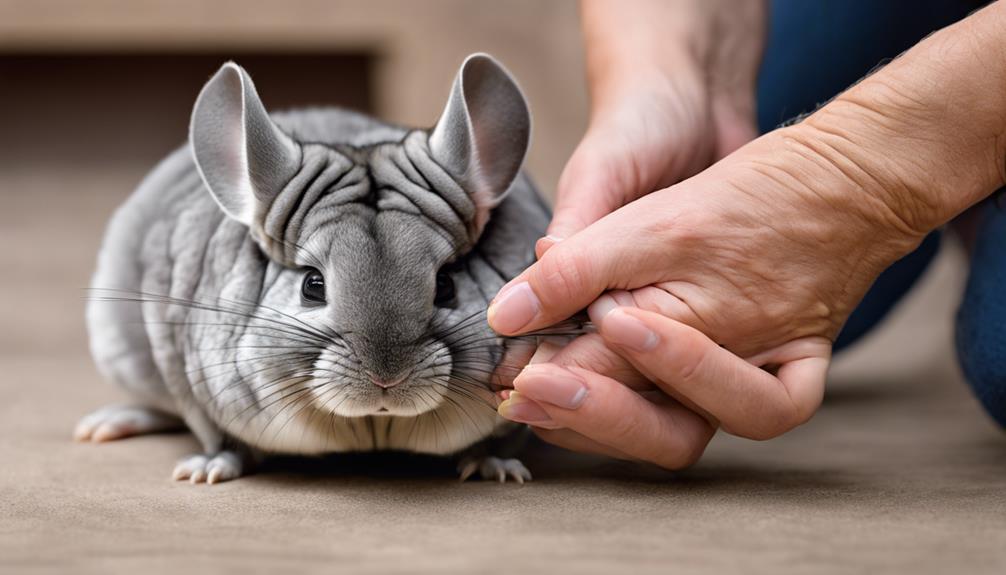
Chinchillas are unique pets that require specific care to stay healthy and happy. One crucial aspect of their well-being is foot care. Due to their sensitive feet and unique anatomy, chinchillas are prone to developing foot problems if their cages are not appropriately maintained.
Regularly checking their feet for signs of injury, overgrown nails, or bumblefoot is essential in preventing more severe issues. Additionally, providing a suitable environment with proper bedding and surfaces to run and play on helps maintain healthy feet. Neglecting foot care can lead to discomfort, pain, and even infections that may affect a chinchilla’s overall health. Therefore, ensuring good foot care practices is vital for chinchilla owners to promote their pets’ well-being and quality of life.
Chinchillas should have a safe cage with a solid floor to prevent injury to their feet. Wire-bottom cages are not suitable for chinchillas as they can cause bumblefoot, a painful condition that results from constant pressure on their feet. Providing a solid surface, such as fleece or aspen bedding, helps protect their feet and prevents injuries.
Regularly trimming their nails is also essential to prevent them from becoming overgrown and causing discomfort. Chinchillas that spend time outside their cages should be supervised to ensure they are in a safe environment that won’t harm their delicate feet. By paying attention to their foot care needs, chinchilla owners can help their pets stay healthy and happy for years to come.
Importance of Foot Health in Chinchillas
Ensuring optimal foot health is crucial for the overall well-being and longevity of chinchillas. Proper foot hygiene is essential to prevent issues such as bumblefoot, a painful condition caused by bacterial infections. Chinchilla owners should regularly clean their pets’ cages to remove any wet bedding or droppings that could lead to infections. Additionally, providing suitable flooring, such as solid surfaces or fleece liners, can help maintain good foot health.
When it comes to footwear options for chinchillas, it’s best to avoid anything that could constrict their delicate feet. Opt for natural wood perches or shelves in their enclosures to promote healthy foot posture and prevent injuries. Chinchillas naturally have strong feet designed for gripping and jumping, so maintaining their environment with appropriate exercise opportunities is vital.
A balanced diet is also crucial for foot health in chinchillas. Providing a mix of high-quality hay, pellets, and fresh vegetables can help prevent obesity, which can lead to foot problems. Chinchillas should have ample space to exercise to keep their muscles and bones strong, ultimately supporting their foot health.
Common Foot Problems in Chinchillas
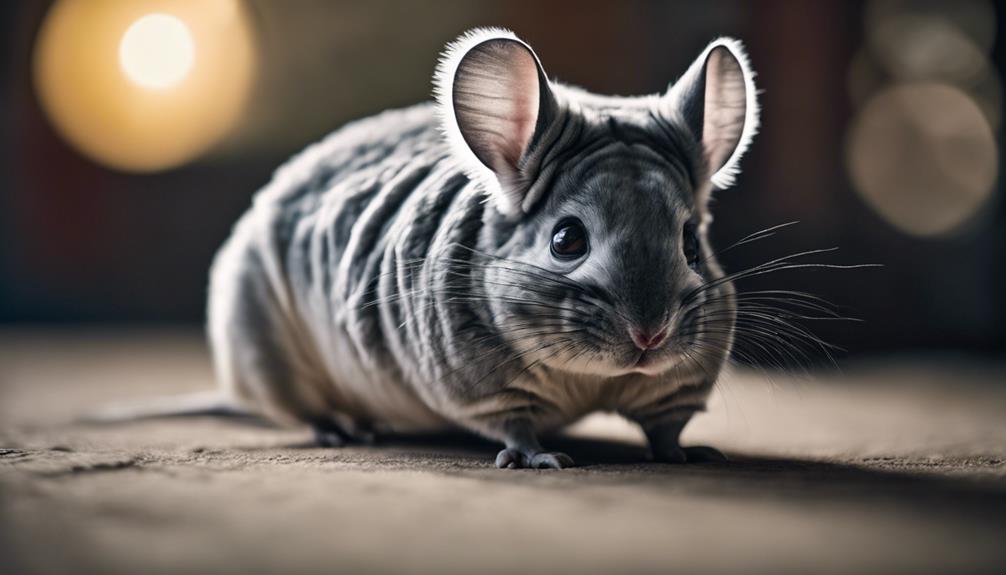
Chinchillas are prone to several common foot problems that can impact their overall health and well-being. Proper foot hygiene and care are essential to prevent issues such as fungal infections and callus formation. Here is a breakdown of some common foot problems in chinchillas:
| Foot Problem | Description | Prevention |
|---|---|---|
| Fungal Infections | Chinchillas can develop fungal infections on their feet due to unclean living conditions or poor hygiene. | Regularly clean the chinchilla’s living area, ensure dry bedding, and monitor foot cleanliness. |
| Callus Formation | Calluses can form on a chinchilla’s feet from walking on improper bedding or rough surfaces. | Use proper bedding materials such as fleece or paper-based bedding to prevent callus development. |
Ensuring proper foot hygiene and providing suitable bedding are crucial in maintaining healthy chinchilla feet. By being proactive in preventing these common foot problems, chinchilla owners can help their pets lead comfortable and active lives.
Signs of Unhealthy Chinchilla Feet
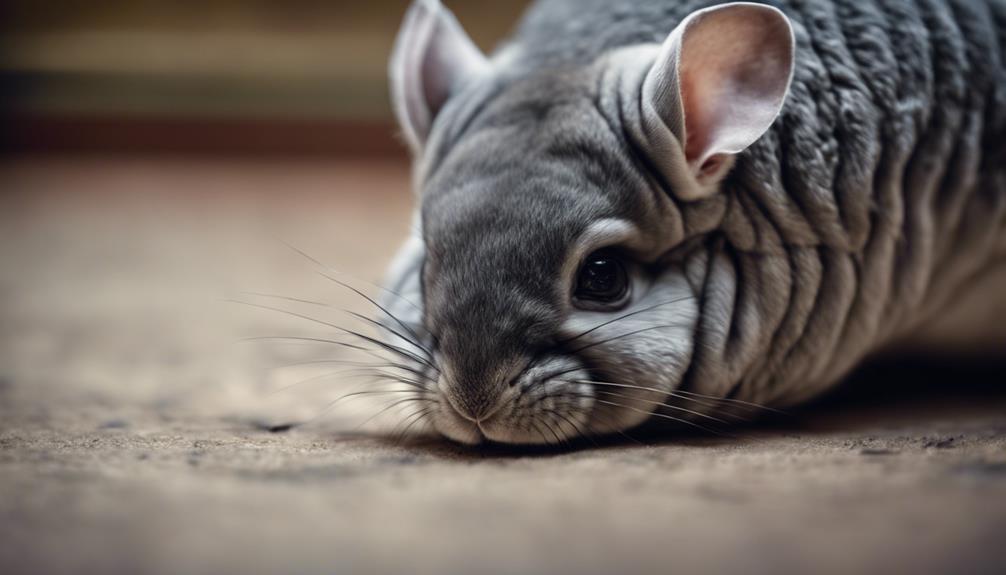
Unhealthy chinchilla feet can exhibit signs such as redness or swelling, indicating possible inflammation or infection.
Another concerning sign is excessive hair loss on the feet, which could signal underlying issues that need attention.
Monitoring these indicators regularly is crucial in maintaining the overall health and well-being of chinchillas.
Redness or Swelling
What are the common indicators of foot issues in chinchillas, specifically redness or swelling, that require immediate attention? Redness on a chinchilla’s feet can be a sign of irritation or infection, while swelling may indicate an injury or underlying health problem. Prompt treatment is crucial to prevent further complications. To address redness, gentle cleaning with a mild antiseptic solution and keeping the cage clean can help prevent infection. Swelling should be examined by a veterinarian to determine the cause and appropriate treatment. Regularly checking your chinchilla’s feet for any signs of redness or swelling is essential for maintaining their overall health and well-being.
| Redness Treatment | Swelling Prevention |
|---|---|
| Clean with antiseptic | Provide a spacious cage |
| Monitor for infection | Remove potential hazards |
Excessive Hair Loss
Excessive hair loss on a chinchilla’s feet can be a significant indicator of underlying health issues that require immediate attention and intervention. When observing excessive hair loss in a chinchilla, it’s crucial to consider the following:
- Nutritional Supplements: Ensuring your chinchilla receives adequate vitamins and minerals can promote healthy fur growth and prevent fur discoloration.
- Bedding Options: Evaluate the bedding material used as some substrates may cause irritation leading to excessive scratching and subsequent hair loss.
- Excessive Scratching: Monitor your chinchilla for signs of excessive scratching, as this behavior can result in hair loss and potential skin damage if left unchecked.
Attentiveness to these factors can aid in maintaining your chinchilla’s foot health and overall well-being.
Preventative Foot Care Measures
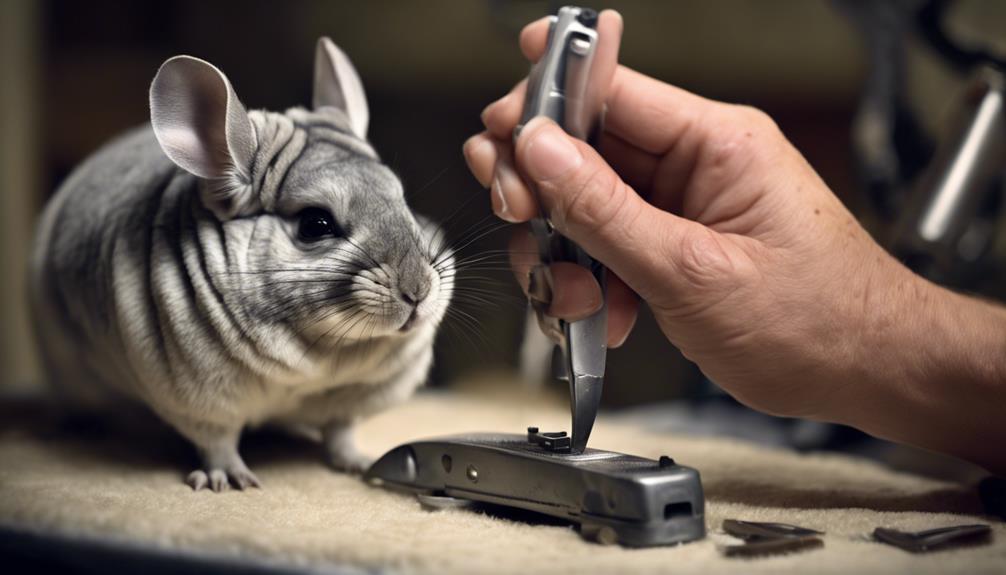
To maintain healthy foot condition in chinchillas, implementing a regular trimming schedule for their nails is essential. In addition to nail trimming, foot hygiene plays a crucial role in preventing foot issues in chinchillas. Ensuring that their living environment is clean and dry can help prevent infections and other foot-related problems. Choosing appropriate bedding that’s soft, dust-free, and absorbent can also contribute to maintaining good foot health in these small animals.
Moreover, incorporating preventative measures into their care routine is key. Providing chinchillas with a suitable exercise routine can help prevent overgrown nails and promote proper weight distribution on their feet. Encouraging regular physical activity through playtime and interactive toys can aid in keeping their foot muscles strong and healthy.
Proper Nail Trimming Techniques
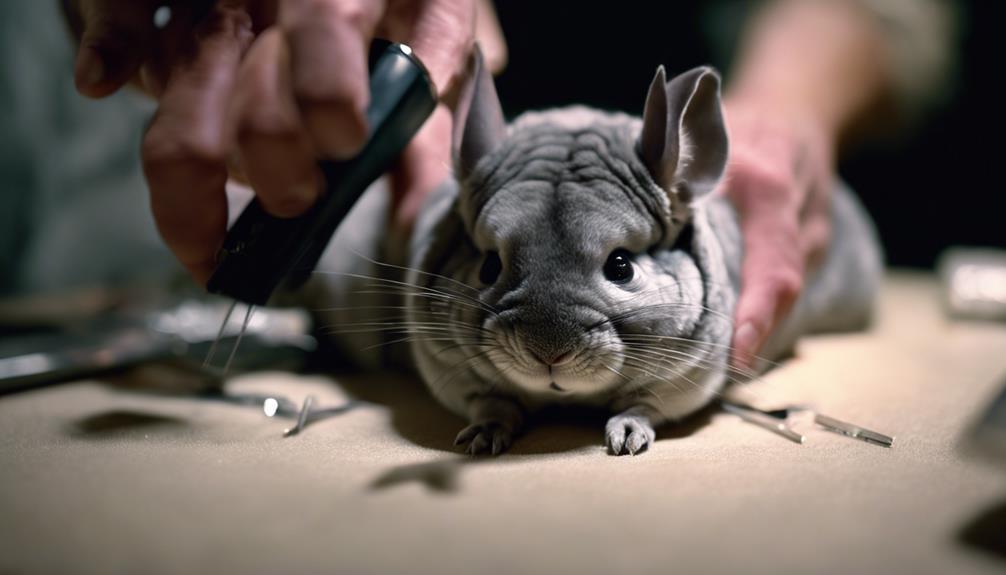
Chinchilla owners must maintain awareness of their pet’s nail length to prevent overgrowth. Proper tools for trimming include small animal nail clippers or human nail clippers with a nail file for finishing.
Demonstrating the correct technique ensures a safe and effective nail trimming process for chinchillas.
Nail Length Awareness
When maintaining the foot health of chinchillas, it’s crucial to be mindful of nail length and utilize proper trimming techniques. Chinchillas’ nails continuously grow, and if left unchecked, they can curl into the footpad causing pain and difficulty in walking. To maintain optimal nail length and health, chinchilla owners should incorporate regular nail trimming into their grooming routine. This helps prevent overgrowth and potential injuries.
Additionally, promoting good foot hygiene by keeping the cage clean and providing appropriate substrates can aid in maintaining nail length. Chinchillas with adequate exercise habits tend to naturally wear down their nails, reducing the frequency of trimming needed.
- Regular nail trimming in grooming routine
- Promoting foot hygiene for optimal nail health
- Encouraging exercise habits to naturally wear down nails
Tools for Trimming
Maintaining the foot health of chinchillas requires the use of appropriate tools for trimming their nails effectively and safely. Proper grooming tools are essential for this task. Nail clippers specifically designed for small animals, such as guillotine-style or scissor-type clippers, are recommended.
It’s important to choose clippers that are sharp to ensure a clean cut, minimizing the risk of splintering or crushing the nail. Additionally, having styptic powder on hand is crucial in case of accidental bleeding.
Before trimming, it’s advisable to have a firm grip on the chinchilla’s paw to prevent sudden movements. By using the right grooming tools and following proper nail trimming techniques, chinchilla owners can help maintain their pets’ foot health and overall well-being.
Technique Demonstration
Using sharp, small animal-specific nail clippers is essential for effectively and safely trimming a chinchilla’s nails. When demonstrating proper nail trimming techniques, it’s crucial to highlight the following:
- Demonstration Benefits:
- Helps prevent overgrowth and curling of nails.
- Reduces the risk of injuries and discomfort for the chinchilla.
- Promotes a healthy posture and gait for the chinchilla.
Proper handling techniques involve securing the chinchilla gently but securely to prevent sudden movements. Begin by identifying the quick in each nail and avoiding cutting into it. Make precise, quick cuts to minimize stress on the chinchilla. Always have styptic powder on hand in case of accidental bleeding.
Creating a Suitable Habitat for Healthy Feet
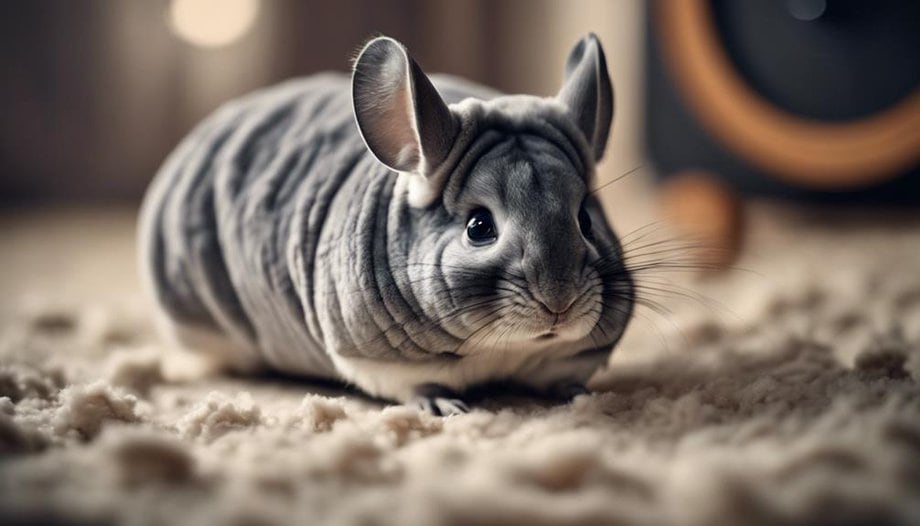
Chinchillas require a habitat that prioritizes environmental enrichment to ensure healthy feet. When setting up a habitat for chinchillas, it’s crucial to consider their unique needs. Providing a spacious enclosure with multiple levels for climbing and jumping helps to promote natural behaviors and foot exercise. The habitat should also include safe materials for bedding, such as aspen shavings or paper-based bedding, to ensure comfort and cleanliness.
In addition to suitable bedding options, incorporating a solid surface, like a wooden platform or tile, into the habitat can help trim the chinchilla’s nails naturally as they move around. This prevents overgrowth that can lead to foot problems. Ensuring that the habitat is kept clean and dry is essential to prevent bacterial or fungal infections that could affect the chinchilla’s feet. By carefully designing and maintaining their habitat, chinchilla owners can promote healthy feet and overall well-being for their furry companions.
Consulting a Veterinarian for Foot Issues
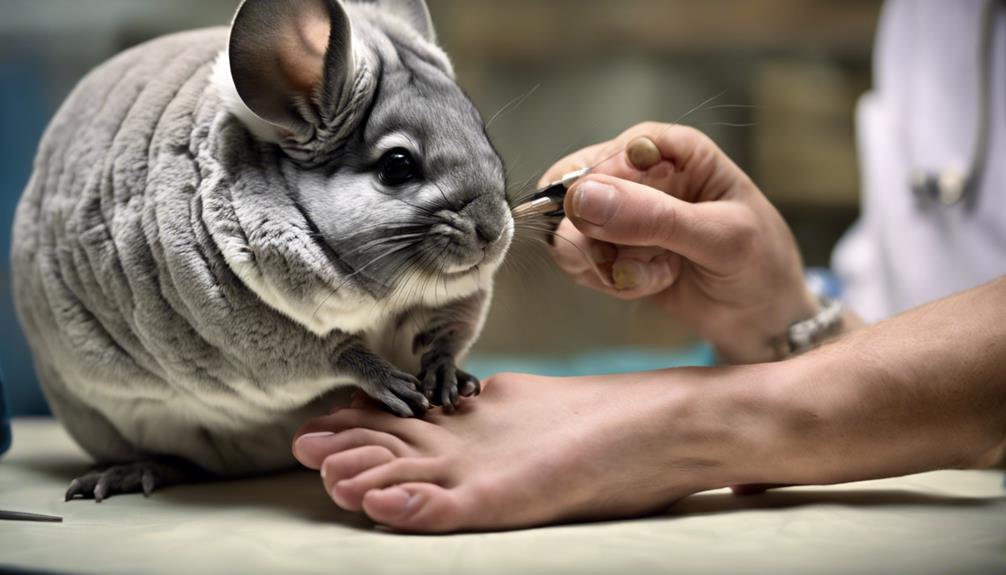
When seeking guidance for foot issues in chinchillas, a veterinarian specializing in exotic pets should be consulted promptly. Chinchilla podiatry requires specific knowledge and expertise due to the unique anatomy and behaviors of these small mammals. Veterinary guidance is essential to properly diagnose and treat any foot problems that may arise.
Here are some reasons why consulting a veterinarian for foot issues in chinchillas is crucial:
- Specialized Care: A veterinarian with experience in exotic pets can provide specialized care tailored to chinchilla podiatry.
- Accurate Diagnosis: Professional advice ensures an accurate diagnosis of foot issues, which is crucial for effective treatment.
- Preventative Measures: Regular consultations can help prevent potential foot problems, promoting the overall health and well-being of chinchillas.
Frequently Asked Questions
Can Chinchillas Wear Shoes or Boots to Protect Their Feet?
Chinchillas cannot wear shoes or boots for protection. Their foot health relies on proper cage flooring and nail maintenance. Preventing issues like bumblefoot is crucial. Owners should prioritize a suitable environment and regular grooming to safeguard their chinchilla’s feet.
Are There Any Natural Remedies or Supplements That Can Improve the Foot Health of Chinchillas?
Herbal remedies and supplements, like a soothing balm for weary feet, can enhance the foot health of chinchillas. These natural foot care options provide nourishment and support, aiding in maintaining the well-being of their precious paws.
Do Chinchillas Need Regular Foot Massages to Maintain Healthy Feet?
Chinchillas benefit from regular foot massages to promote circulation and overall foot hygiene. Additionally, suitable footwear options like safe bedding materials can help maintain healthy feet by preventing injuries and reducing the risk of pododermatitis.
Can Chinchillas Develop Calluses on Their Feet, and if So, How Should They Be Treated?
Chinchillas can develop calluses on their delicate feet due to improper flooring or excessive activity. Preventing calluses involves providing suitable bedding and using specialized foot care products. Regular checks and adjustments can help maintain healthy feet.
Are There Specific Exercises or Activities That Can Help Strengthen Chinchilla Feet and Prevent Foot Problems?
Chinchillas can benefit from foot exercises like gentle climbing on safe structures or using a running wheel. These activities help strengthen their feet and prevent foot problems by promoting circulation and muscle tone.











